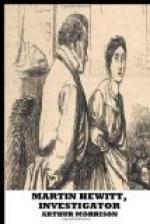The reward remained on offer for a long time; indeed, it was never publicly withdrawn, I believe, even at the time of Claridge’s death. And several intelligent newspapers enlarged upon the fact that an ordinary burglar had completely baffled and defeated the boasted acumen of Mr. Martin Hewitt, the well-known private detective.
VII.
THE AFFAIR OF THE TORTOISE.
Very often Hewitt was tempted, by the fascination of some particularly odd case, to neglect his other affairs to follow up a matter that from a business point of view was of little or no value to him. As a rule, he had a sufficient regard for his own interests to resist such temptations, but in one curious case, at least, I believe he allowed it largely to influence him. It was certainly an extremely odd case—one of those affairs that, coming to light at intervals, but more often remaining unheard of by the general public, convince one that, after all, there is very little extravagance about Mr. R.L. Stevenson’s bizarre imaginings of doings in London in his “New Arabian Nights.” “There is nothing in this world that is at all possible,” I have often heard Martin Hewitt say, “that has not happened or is not happening in London.” Certainly he had opportunities of knowing.
The case I have referred to occurred some time before my own acquaintance with him began—in 1878, in fact. He had called one Monday morning at an office in regard to something connected with one of those uninteresting, though often difficult, cases which formed, perhaps, the bulk of his practice, when he was informed of a most mysterious murder that had taken place in another part of the same building on the previous Saturday afternoon. Owing to the circumstances of the case, only the vaguest account had appeared in the morning papers, and even this, as it chanced, Hewitt had not read.
The building was one of a new row in a partly rebuilt street near the National Gallery. The whole row had been built by a speculator for the purpose of letting out in flats, suites of chambers, and in one or two cases, on the ground floors, offices. The rooms had let very well, and to desirable tenants, as a rule. The least satisfactory tenant, the proprietor reluctantly admitted, was a Mr. Rameau, a negro gentleman, single, who had three rooms on the top floor but one of the particular building that Hewitt was visiting. His rent was paid regularly, but his behavior had produced complaints from other tenants. He got uproariously drunk, and screamed and howled in unknown tongues. He fell asleep on the staircase, and ladies were afraid to pass. He bawled rough chaff down the stairs and along the corridors at butcher-boys and messengers, and played on errand-boys brutal practical jokes that ended in police-court summonses. He once had a way of sliding down the balusters, shouting: “Ho! ho! ho! yah!” as he went, but as he was a big, heavy man, and the balusters had been built for different treatment, he had very soon and very firmly been requested to stop it. He had plenty of money, and spent it freely; but it was generally felt that there was too much of the light-hearted savage about him to fit him to live among quiet people.




